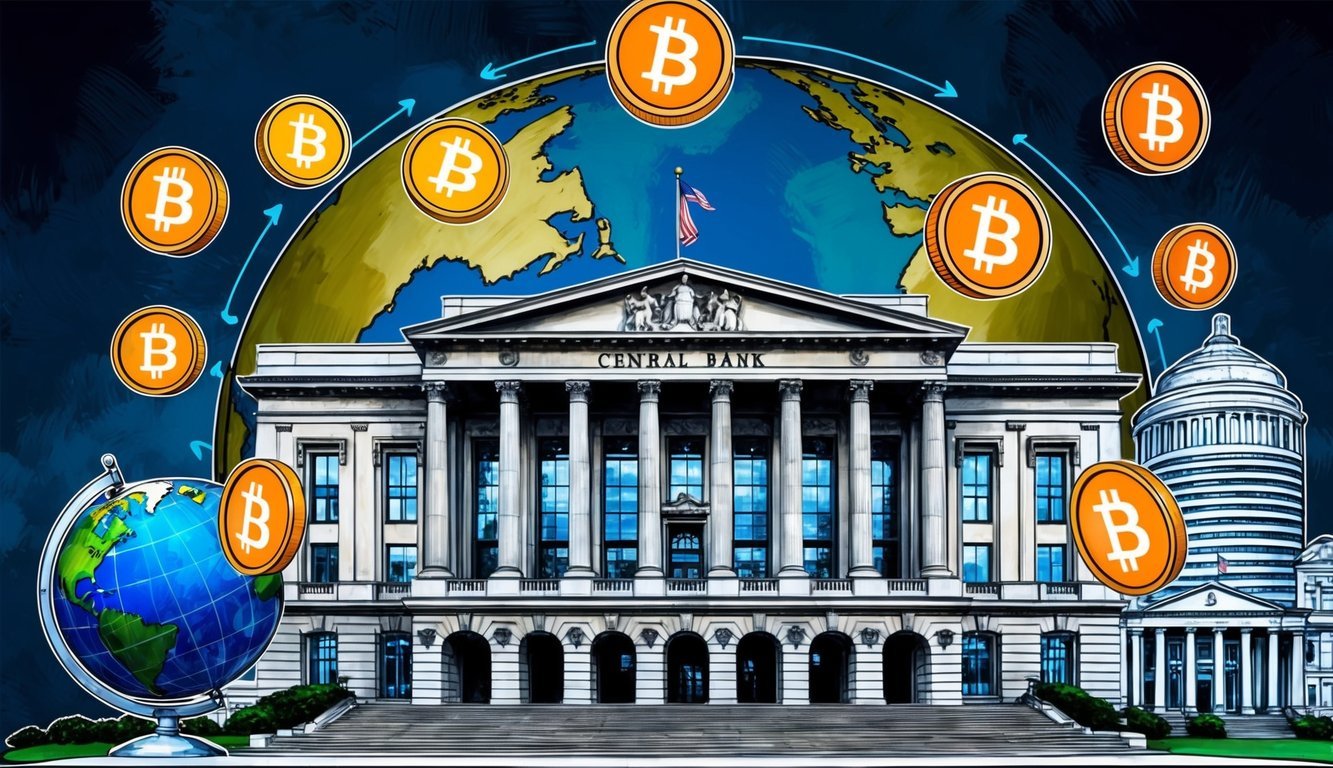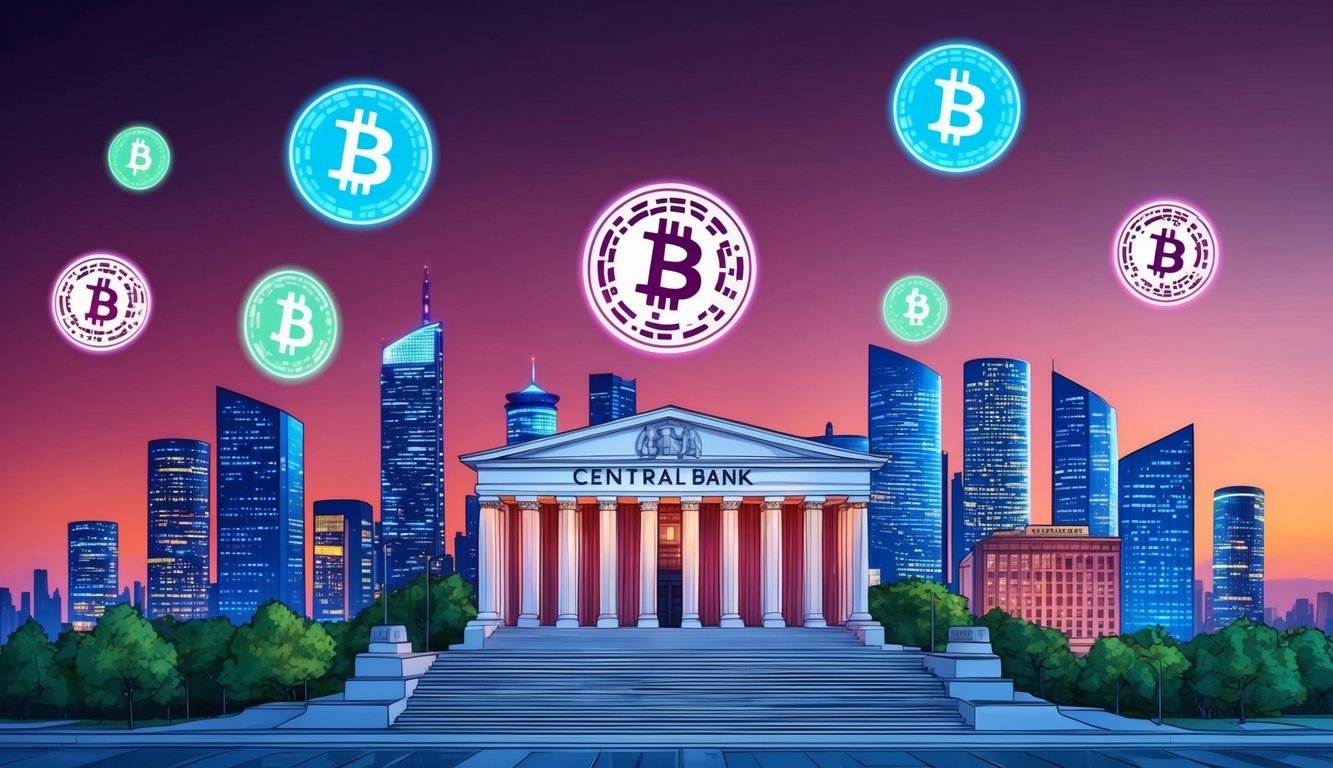Money is changing fast. Banks and governments are looking at new ways to make payments easier and safer. One big idea is Central Bank Digital Currencies (CBDCs). These are digital versions of regular money, backed by a country’s central bank.

CBDCs are like digital cash that you can use to buy things or send money to friends.
They’re different from the money in your bank account or the cash in your wallet. CBDCs use special technology to work, kind of like the tech behind Bitcoin, but controlled by the government.Many countries are thinking about making their own CBDCs. They think it could help more people use banks, make payments faster, and even change how the economy works. But there are also worries about privacy and how it might affect regular banks.
Key Takeaways
- CBDCs are digital versions of regular money issued by central banks
- They could make payments faster and help more people use financial services
- CBDCs might change how banks work and how governments control money
Understanding CBDCs and the Financial Landscape
Central bank digital currencies are changing how we think about money. They offer new ways to pay and save that could affect your daily life.
What Are CBDCs?
CBDCs are digital forms of a country’s official money. They’re issued by central banks, just like paper cash. But you can use them electronically, similar to how you use digital bank accounts now.
CBDCs aim to make payments faster and cheaper. They could help more people access banking services, especially those without traditional bank accounts.
These digital currencies are backed by the government, making them different from cryptocurrencies like Bitcoin. You can trust their value to stay stable, just like regular money.
CBDCs vs. Cryptocurrencies
While both are digital, CBDCs and cryptocurrencies are quite different. CBDCs are controlled by central banks, but cryptocurrencies aren’t run by any single authority.
Your CBDC transactions might be traceable by the government, which could help fight money laundering. This raises questions about privacy, though. Cryptocurrencies often offer more anonymity.
CBDCs will likely be more stable in value than most cryptocurrencies. You won’t see wild price swings like with Bitcoin.
Types of CBDCs: Retail and Wholesale
There are two main types of CBDCs: retail and wholesale. Retail CBDCs are for you and me – everyday people and businesses. You could use them to buy groceries or pay bills.
Wholesale CBDCs are for banks and big financial institutions. They’re used for large transactions between these organizations.
Retail CBDCs could change how you manage your money. You might not need a regular bank account anymore. Wholesale CBDCs, on the other hand, could make the financial system work more smoothly behind the scenes.
The Technology Behind CBDCs
CBDCs use cutting-edge tech to create secure digital money. Let’s look at the key systems that make these new currencies work.
Blockchain and Distributed Ledger Technology
CBDCs often use blockchain or distributed ledger technology. This helps track transactions without a central database. Here’s how it works:
• Each transaction is a “block” in a chain
• The chain is copied across many computers
• This makes it hard to hack or change
You might see two main types of CBDCs:
- Token-based: Like digital cash you keep in a wallet
- Account-based: Tied to your bank account
Both use special codes to keep your money safe. The tech makes sure you can’t spend the same money twice.
Ensuring Security and Privacy in Digital Currency
CBDCs need to be super secure. Banks use strong cybersecurity measures to protect your digital cash. They also have to balance privacy with following the law.
Here’s what you should know:
• Your transactions are encrypted
• Banks can trace big transfers to stop crime
• You might use a digital wallet to store your CBDCs
Privacy is a big deal. Some worry that CBDCs could let banks see all your spending. But many countries are working on ways to keep your info private.
Payment Systems Integration
For CBDCs to work, they need to fit with current payment systems. This means updating ATMs, card readers, and online banking.
You might soon be able to:
• Pay with CBDCs using your phone
• Send money instantly to friends
• Use CBDCs for online shopping
Banks are testing how to make CBDCs work smoothly with what we already use. The goal is to make paying with digital currency as easy as using cash or a debit card.
Impact of CBDCs on Economy and Society
CBDCs could change how you handle money and interact with the financial system. They might boost economic growth, help more people access banking, and shake up international payments.
Contributions to Economic Growth
CBDCs might give your country’s economy a boost. They could make payments faster and cheaper, helping businesses run smoother. This could lead to more trade and economic activity.
With CBDCs, your government might find it easier to give out financial aid or stimulus payments. They could send money straight to your digital wallet in times of crisis.
CBDCs could also help fight tax evasion and illegal activities. This might mean more money for public services you use.
Financial Inclusion and a Cashless Society
CBDCs could be a game-changer if you don’t have a bank account. You might be able to get a digital wallet without the usual hurdles of opening a bank account.
This could help you save money, get loans, and make payments more easily. It’s like having a bank in your pocket.
As more people use CBDCs, you might see less cash around. This could make theft harder and reduce the costs of handling physical money.
But remember, not everyone is tech-savvy. Some folks might struggle with the shift to digital money.
Changing Dynamics of International Payments
CBDCs could make sending money abroad much easier for you. You might be able to transfer money to other countries faster and with lower fees.
This could be great if you work abroad or have family overseas. You’d spend less on transfer fees and get money to loved ones quicker.
For businesses, CBDCs might simplify international trade. They could make cross-border payments smoother and reduce currency exchange hassles.
Regulation, Adoption, and the Future of CBDCs

CBDCs are changing money as we know it. They bring new rules, global efforts, and big changes for how we’ll use money in the future.
Developing a Regulatory Framework
You might wonder how CBDCs will be controlled. Countries are working on rules to keep your money safe. These rules will cover things like consumer protection and privacy.
Central banks want to make sure CBDCs work well with the current money system. They’re looking at how to:
- Keep your digital cash private
- Stop criminals from using CBDCs
- Make sure the system is fair for everyone
It’s a tricky balance. Banks need to protect you while still making CBDCs easy to use.
Global CBDC Initiatives and Adoption Challenges
Many countries are testing CBDCs. Some are moving faster than others. You’ll see different approaches based on what each country needs.
Here are some challenges in adopting CBDCs:
- Getting people to trust and use them
- Making sure they work with other payment systems
- Keeping the financial system stable
Big countries like China are leading the way. Smaller nations are also jumping in. Each faces unique hurdles in making CBDCs work for their citizens.
Visioning the Future: CBDCs in the Global Economy
CBDCs could change how you shop, save, and send money. They might make payments faster and cheaper. You could see a more cashless society in the future.
Some possible changes:
- Easier cross-border payments
- New types of financial services
- More control over monetary policy for central banks
But there are risks too. Your country will need to protect its monetary power. And everyone will need to learn how to use this new form of money.
CBDCs could make the global economy more connected. But it’ll take time to get there. You’ll likely see gradual changes as countries figure out what works best.
Frequently Asked Questions

CBDCs are new digital forms of money created by central banks. They could change how we use money and interact with the financial system. Let’s dive into some key questions about these digital currencies.
What’s the lowdown on CBDCs and how do they work?
CBDCs are digital versions of a country’s official currency. They’re issued and backed by the central bank, just like paper money.
You’d use CBDCs through a digital wallet on your phone or computer. They work a lot like the digital money in your bank account now, but with some key differences.
Are any countries already using digital currencies issued by their central banks?
Yes, a few countries have launched CBDCs. The Bahamas introduced the Sand Dollar in 2020.
China is testing its digital yuan in several cities. Nigeria and Jamaica have also rolled out their own versions.
How might a CBDC rollout affect the way we use cash today?
A CBDC could make digital payments easier and faster. You might use less physical cash for everyday purchases.
But don’t worry, cash won’t disappear overnight. Many countries plan to keep cash available alongside CBDCs.
What’s the deal with the US potentially getting its own digital dollar?
The US is exploring the idea of a digital dollar. The Federal Reserve is researching the pros and cons.
They’re looking at how it could affect the economy, privacy, and financial inclusion. No decision has been made yet on whether to create one.
When’s the big day that a CBDC might drop in our digital wallets?
That’s a tough one to predict. It depends on the country and how fast they move.
For the US, it could be several years away if they decide to go ahead. Other countries might move faster.
What kind of impact could central bank digital currencies have on the traditional banking system?
CBDCs could shake things up for banks. They might compete with bank deposits.
Banks might need to offer new services to stay competitive. But they’ll likely still play a key role in lending and other financial services.




